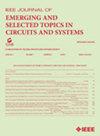To Spike or Not to Spike: A Digital Hardware Perspective on Deep Learning Acceleration
IF 3.7
2区 工程技术
Q2 ENGINEERING, ELECTRICAL & ELECTRONIC
IEEE Journal on Emerging and Selected Topics in Circuits and Systems
Pub Date : 2023-11-06
DOI:10.1109/JETCAS.2023.3330432
引用次数: 0
Abstract
As deep learning models scale, they become increasingly competitive from domains spanning from computer vision to natural language processing; however, this happens at the expense of efficiency since they require increasingly more memory and computing power. The power efficiency of the biological brain outperforms any large-scale deep learning (DL) model; thus, neuromorphic computing tries to mimic the brain operations, such as spike-based information processing, to improve the efficiency of DL models. Despite the benefits of the brain, such as efficient information transmission, dense neuronal interconnects, and the co-location of computation and memory, the available biological substrate has severely constrained the evolution of biological brains. Electronic hardware does not have the same constraints; therefore, while modeling spiking neural networks (SNNs) might uncover one piece of the puzzle, the design of efficient hardware backends for SNNs needs further investigation, potentially taking inspiration from the available work done on the artificial neural networks (ANNs) side. As such, when is it wise to look at the brain while designing new hardware, and when should it be ignored? To answer this question, we quantitatively compare the digital hardware acceleration techniques and platforms of ANNs and SNNs. As a result, we provide the following insights: (i) ANNs currently process static data more efficiently, (ii) applications targeting data produced by neuromorphic sensors, such as event-based cameras and silicon cochleas, need more investigation since the behavior of these sensors might naturally fit the SNN paradigm, and (iii) hybrid approaches combining SNNs and ANNs might lead to the best solutions and should be investigated further at the hardware level, accounting for both efficiency and loss optimization."秒杀 "还是 "不秒杀"?深度学习加速的数字硬件视角
随着深度学习模型规模的扩大,它们在从计算机视觉到自然语言处理等各个领域的竞争力日益增强;然而,这是以牺牲效率为代价的,因为它们需要越来越多的内存和计算能力。生物大脑的能效优于任何大规模深度学习(DL)模型;因此,神经形态计算试图模仿大脑的操作,如基于尖峰的信息处理,以提高 DL 模型的效率。尽管大脑具有高效的信息传输、密集的神经元互连以及计算与记忆共存等优点,但现有的生物基质严重制约了生物大脑的进化。电子硬件没有同样的限制;因此,尽管尖峰神经网络(SNN)建模可能会揭开谜题的一角,但为尖峰神经网络设计高效的硬件后端还需要进一步研究,有可能从人工神经网络(ANN)方面的现有工作中汲取灵感。因此,在设计新硬件时,什么时候研究大脑是明智之举,什么时候应该忽略它?为了回答这个问题,我们对 ANN 和 SNN 的数字硬件加速技术和平台进行了定量比较。结果,我们提出了以下见解:(i) 目前,ANNs 处理静态数据的效率更高;(ii) 针对神经形态传感器(如基于事件的摄像头和硅耳蜗)产生的数据的应用需要更多研究,因为这些传感器的行为可能自然地符合 SNNs 范式;(iii) SNNs 和 ANNs 的混合方法可能会带来最佳解决方案,应在硬件层面进一步研究,同时考虑效率和损耗优化。
本文章由计算机程序翻译,如有差异,请以英文原文为准。
求助全文
约1分钟内获得全文
求助全文
来源期刊

IEEE Journal on Emerging and Selected Topics in Circuits and Systems
ENGINEERING, ELECTRICAL & ELECTRONIC-
CiteScore
8.50
自引率
2.20%
发文量
86
期刊介绍:
The IEEE Journal on Emerging and Selected Topics in Circuits and Systems is published quarterly and solicits, with particular emphasis on emerging areas, special issues on topics that cover the entire scope of the IEEE Circuits and Systems (CAS) Society, namely the theory, analysis, design, tools, and implementation of circuits and systems, spanning their theoretical foundations, applications, and architectures for signal and information processing.
 求助内容:
求助内容: 应助结果提醒方式:
应助结果提醒方式:


